An Inside Look at Nike’s Sub-2-Hour Marathon Quest
An exclusive, behind-the-scenes look at how Nike is trying to break the 2-hour marathon barrier. – By Alex Hutchinson

Standing on the sweeping bend of the infamous Curva Parabolica, three of the greatest distance runners in history shiver in the late-afternoon breeze, awaiting the signal to begin.
Around them, an uncanny silence prevails. The Autodromo Nazionale Monza, a historic Formula One racetrack nestled in the woodlands of a former royal park northeast of Milan, can seat 115,000 spectators. Since its construction back in 1922, the “Temple of Speed,” as it’s affectionately known, has echoed with the high-octane roar of epic races, hosted countless speed records (at 372.6km/h, which Colombian driver Juan Pablo Montoya reached in the 2005 Italian Grand Prix, a marathon would take less than seven minutes), and mourned the deaths of more than 50 drivers and 40 spectators, mostly in the freewheeling early days of motorsport.
On this bright day in early March, though, the stands are deserted. On the track are reigning Olympic Marathon champion Eliud Kipchoge, half marathon world record holder Zersenay Tadese, and rising star Lelisa Desisa. Clustered around them are a hand-picked group of 11 Kenyan and Ethiopian runners, flown to Italy for the sole purpose of setting the pace and blocking the wind for the chosen three, plus a small crew of harried and visibly nervous scientists. Since last December, when Nike revealed that it was marshalling its considerable resources for a springtime assault on the two-hour marathon barrier, speculation had swirled about how, precisely, the company planned to slice such a big chunk off Kenyan Dennis Kimetto’s 2014 world record of 2:02:57. Would they run down a mountain? Wear rocket-powered shoes in a giant wind tunnel? Now the veil will finally be lifted, as Kipchoge, Tadese, and Desisa prepare to run a test half marathon with a goal time of exactly 60 minutes. After almost three years of planning, it’s time for a reality check.
In the hours leading up to the start, Brad Wilkins, Ph.D., director of Next Generation Research in the Nike Sport Research Laboratory and the lead on the project’s scientific strategy, was sweating the details. Striding down Monza’s imposing, storied finishing straight, he pointed out the pancake-flat timing mats that were being laid down at intervals of exactly 400 metres, in order to provide hyperaccurate pace feedback to the runners every 68 seconds (if they’re on pace). His team had set up two weather stations to gather track-level data on temperature, humidity, and wind speed for the full marathon attempt, slated for the 6th, 7th, or 8th May, depending on weather conditions. The wind, he acknowledged, was bad – bad enough to merit postponing the attempt, if this were the real thing rather than a dress rehearsal. He paused and looked up at the sky, which was that intense shade of azure, artfully dotted with a few fluffy white clouds, that reassures you that spring is coming and the universe is basically a good place. “As a physiologist,” he added, “another thing I don’t like is the sun. Too much radiant heat.”
Finally, with the bleat of an asthmatic-sounding air-horn, the runners set off, following a sleek (and exhaust-free) black Tesla pace car driven by a Formula One test driver whose skills are necessary to maintain a steady pace while attempting to stay consistently at least five meters in front of the pack. The first six pacemakers quickly coalesce into an arrowhead formation in rows of one, two, and three – think Flying V – with Kipchoge, Tadese, and Desisa tucked tightly behind them. A pair of digital clocks mounted on the Tesla display real-time updates: elapsed time, current pace, projected finishing time. With languid strides and impassive visages, the three men make their superhuman pace look deceptively human – for now.
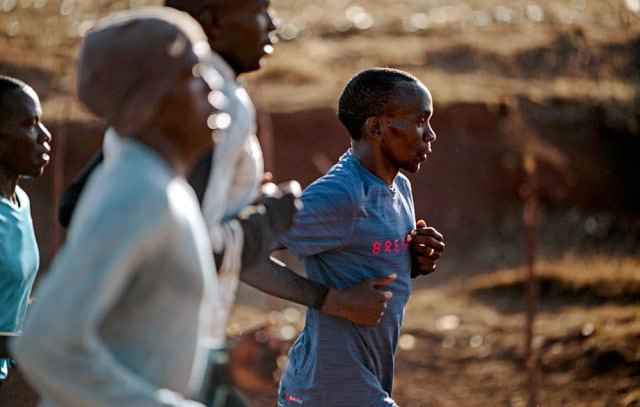
When the official corporate history of Nike’s Breaking2 project is finally written, it will undoubtedly wax poetic about “testing the limits of the human heart” (as the company’s initial press release put it) and moon landings and Roger Bannister. “We felt that this is one of those Holy Grail barriers” is how Nike chairman and CEO Mark Parker explained the program’s origins in a recent episode of The Runner’s World Show podcast. And, having spent five months behind the scenes following the initiative and getting to know some of the people involved, I don’t doubt the sincerity of those motivations.
The scent of a sub-two marathon, after all, has been in the air for a few years now. While the women’s world record hasn’t budged since Paula Radcliffe’s 2:15:25 in 2003, the men’s record has dropped six times in that span. Jos Hermens, a garrulous Dutch athletics manager who represents Kipchoge and Ethiopian great Kenenisa Bekele, says the idea first started to seem plausible back in 2008 when Haile Gebrselassie became the first man to run under 2:04. A 2011 paper in the Journal of Applied Physiology titled, “The two-hour marathon: who and when?” sparked 38 responses from other researchers on the various factors that might bring the barrier closer. And in late 2014, shortly after Kimetto dipped under 2:03 at the Berlin Marathon, Yannis Pitsiladis, a professor of sport and exercise science at Britain’s University of Brighton launched his own Sub2Hr Project. That initiative now includes top runners, including Bekele, who plan to pursue a sub-two within five years.
Still, two minutes and 58 seconds remains a substantial gap. It’s 2.4 percent away from the barrier, a distance that has rarely in the history of athletics been bridged in a single leap. Radcliffe improved the women’s record by a total of 1.4 percent in two record runs; Usain Bolt, as mind-boggling as he is, has only lowered the 100-metre record by 1.6 percent. So what prompts a company to make an enormously quixotic bet whose total cost, in my estimation, will easily run into the millions, if not tens of millions, of dollars? To borrow a convenient catchphrase, “It’s gotta be the shoes!”
In June 2013, Nike’s innovation team launched an internal initiative with the goal of improving running economy by 3 percent – a number with obvious links to the sub-two chase. It was, recalls Tony Bignell, Nike’s VP of Footwear Innovation, a call for substance over hype: “We were pushing for measurable performance gains.” They started with a blank slate, willing to consider even the wackiest-sounding performance-boosters, like pinning your arms to your sides to save wasted motion and energy. Tests on former elite runner Matt Tegenkamp using a specially designed elastic sling showed a measurable efficiency boost, but “you sort of ran like a T-Rex,” said Matthew Nurse, senior director of the Nike Explore Team Sport Research Lab. “Matt hated it.” The project team was also thinking radically, pursuing the goal of a “track spike for the marathon” – a stiff, ultralight shoe built purely for speed. They stripped off any extraneous components, ditching cushioning and leaving outsole rubber only where the foot hits the ground; in one prototype, they chopped off the heel completely, since elite distance runners generally land on their forefeet. There was just one problem: The shoes were all but unwearable. For 42.2 kilometres on paved roads, the athletes insisted, they wanted a softer ride.

The team’s solution, according to Geng Luo, Ph.D., an earnest and excitable senior biomechanics researcher who joined Nike in 2013, was to shift the focus from “lightweight” to “right weight.” A new cushioning foam, which the company dubbed Nike ZoomX, offered a cross between the properties of plastic and rubber at a third the weight of usual midsole materials. That allowed the team to adopt a much thicker, springier sole without weighing down the shoe. Then, within this thick sole, they embedded a thin, curved, carbon-fibre plate to stiffen the shoe in order to minimise the energy lost when runners’ toes bend, without increasing demand on the calf during pushoff. To get it right, they tested prototype after prototype, going through more than 100 different versions in total. With the rapid prototyping machinery in the company’s top-secret “Innovation Kitchen,” they could produce a completely new shoe in as little as an hour. “For a shoe nerd like myself,” says Luo, who was sketching footwear designs by the time he was 12 years old, “this is heaven.”
Before long, the new approach was yielding eyebrow-raising results in the lab. Test subjects were able to maintain a given pace on the treadmill while burning about 4 percent less energy, on average, than they did in Nike’s top-of-the-line Zoom Streak 6 racing flats. And as some of the company’s sponsored elite runners began giving them a try, the feedback was deafeningly positive: No one wanted to give the prototypes back after testing. Not only did the shoes feel fast, the runners reported, but they also reduced soreness toward the end of long runs, hastened recovery afterward, and cooked a three-course dinner for you. Shalane Flanagan, a former Olympic medallist who was preparing to qualify for her fourth Olympic team, began having nightmares that someone was coming to take her pair away. Flanagan, Amy Cragg, and Galen Rupp all wore the prototypes at the U.S. Olympic Marathon Trials in early 2016, and again at the Rio Olympics. Rupp won marathon bronze; the two men in front of him, Kipchoge and Feyisa Lilesa, were also wearing the shoes.
All of this, meanwhile, remained top secret. But the positive results continued to pile up, and by June 2014, a year after the 3-percent project was launched, the innovation team was ready to make a crucial decision. They weren’t just going to build a supershoe; they were going to organise a sub-two-hour marathon. To do that, they would need to think beyond shoes and apparel and consider every element that could possibly affect marathon times: the athletes, the course, the weather, the race plan, training, nutrition, hydration, psychology. They would consider, and when possible control, every possible detail; they would rethink the very nature of the race. In the face of overwhelming odds, they would follow the lead of Matt Damon’s character in The Martian and science the s— out of 42.2 kilometres.
Fast-forward, then, to 1 December 2016. Kipchoge, Tadese, and Desisa were ushered through security into the Mia Hamm Building on Nike World Headquarters’ manicured mega campus in the Portland, Oregon, suburb of Beaverton, where the Innovation Kitchen and Nike Sport Research Lab are located. Once past the security gates, they entered a hallway leading to the research lab that’s actually a two-lane rubberised track; a giant mural covers the wall at the end of the track reading, in pixelated scoreboard font, “1:59:59.”
The three runners were in Beaverton for a round of physiological tests and product testing; the visit marked the official start of training for a sub-two attempt in the spring. They’d all been tested over the preceding 18 months, as part of an exhaustive athlete selection process quarterbacked by Wilkins and his team with the assistance of outside consultants like Andy Jones, Ph.D., associate dean for research at the University of Exeter in the United Kingdom. Sifting through the vast ranks of Nike-sponsored distance runners – a group that notably omits the three most recent marathon record setters, Kimetto, Wilson Kipsang, and Patrick Makau, who are all sponsored by Adidas – the scientists winnowed the field to runners with sub-2:05 marathon or sub-60:00 half marathon credentials, and invited 18 of the most promising candidates for further testing.
Jones, a dapper and soft-spoken Welshman, was a teen phenom in the 1980s, notching bests of 30:13 for 10K and 1:06:55 for the half marathon as a 17-year-old, the former of which is still a U.K. age-group record. In university, his interests turned to the scientific side of training, and while still a graduate student he agreed to run some tests on a young prospect named Paula Radcliffe, who was struggling with anemia. Their relationship ended up lasting the rest of Radcliffe’s career, and bolstered Jones’s faith in the ability of lab testing to yield valuable insights about a runner’s fitness and race-readiness. In 2002, when Radcliffe was preparing for her marathon debut, Jones told her that based on her lab data, he wouldn’t be surprised if she ran 2:18 – a bold view given that the world record was 2:18:47. She went on to run 2:18:56 in London. Later that year, before the Chicago Marathon, he told her she might be ready to run 2:17; she ran 2:17:18. Finally, the next spring, her lab values indicated a 2:16 – and she ran 2:15:25 in London.
His experience with Radcliffe gave Jones confidence in the power of treadmill testing to predict seemingly improbable feats, but they also underscored other necessary intangibles. “Her capacity to hurt herself was unprecedented,” he says. So while the Breaking2 team assessed their candidates’ lab values – maximal oxygen consumption, lactate threshold, and running economy, which is a measure of efficiency – and had them run three kilometres on the track at sub-two-hour marathon pace followed by an all-out 400-metre lap, they also made more gut-level assessments. They considered the athletes’ swagger, their response to challenges, and other elements of attitude and outlook that might make or break the Breaking2 mission.
Of the three final choices, Kipchoge, the 32-year-old Olympic champion from Kenya, was on paper, the most obvious. His marathon best of 2:03:05, set last year in London, is the third-fastest time in history on a record-eligible course, and he also boasts enviable track credentials at shorter distances. Perhaps surprisingly, his lab tests weren’t as impressive as expected, but as he stepped onto the treadmill in Beaverton, it was apparent why. It was just his second time on the ‘mill, and as he tiptoed with exaggerated care onto the whirring belt, it was hard not to think of Bambi flailing around on the ice. One of the scientists edged around to the back of the treadmill, ready to be a spotter if needed. This was a case where Jones and his colleagues overlooked the lab data: Kipchoge’s outdoor track test and racing credentials, along with his impassive and unshakable self-confidence, made him an easy pick.
Next on the treadmill was Tadese, a 35-year-old from Eritrea with stunning lab tests and a long list of accolades at shorter distances: an Olympic track medallist, a world champion in cross-country and in the half marathon, and the world record holder at the latter distance, with a 58:23. He’s also the subject of a 2007 scientific paper that pegged him as one of the most efficient runners ever measured. The only problem: a history of failed or disappointing marathon attempts, with a relatively modest best time of 2:10:41. After discussions with his coach, Jones and his colleagues concluded that Tadese’s marathon woes might be the result of inadequate in-race fuelling. Fix that problem, they hoped, and they might unleash his considerable potential.
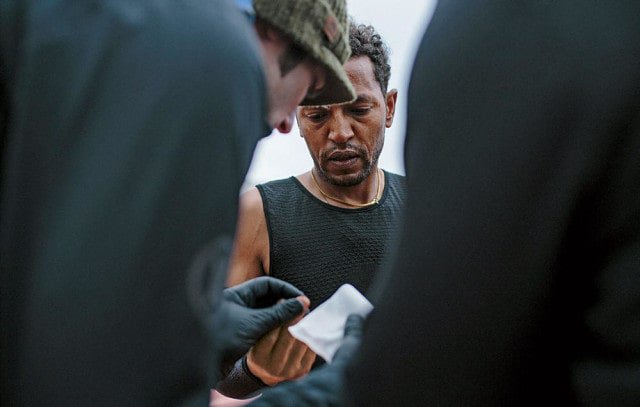
Meanwhile, on another treadmill in a large refrigerated room in the corner of the lab, Desisa was running in a singlet and half tights with eight wireless thermometers attached to various parts of his body. Around him scientists in long sleeves and long pants shivered in the 50-degree air as they assessed his response to the cool conditions they hoped for on race day. The 27-year-old Ethiopian had also impressed in the standard treadmill lab tests, and he had amassed a record of good showings on tough marathon courses including Boston (which he has twice won) and New York City. Like many East African marathon stars, he grew up running to and from a distant rural school, which was nearly an hour’s walk from his home – but that wasn’t far enough for the aspiring runner, so he would give his books to friends and run a longer way home. He was, the team concluded, a gifted racer whose competitive fire, combined with his impressive physiology, might propel him to a sub-two.
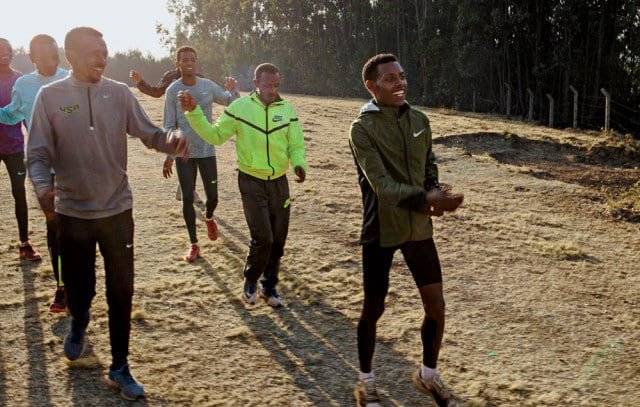
As the runners glide into view along the home straight of the Monza track, Kipchoge, Tadese, and Desisa are all but invisible, tucked behind their protective wall of pacers. After just over five minutes of running, they cross the finish line for the first time, with eight laps of the circuit’s 2.4 kilometre Junior Course remaining. Gathered alongside the finish area are a small group of media and a fresh crew of pacers waiting to take over when needed – a tactic that isn’t available in record-legal races but isn’t without precedent. In 1953, Roger Bannister ran a 4:02.0 mile (1.6km) with the help of an Oxford teammate who allowed himself to be lapped in order to pace the final lap and a half of the race. The result wasn’t ratified as a British record, but it convinced Bannister that the four-minute mark was attainable. When he finally broke the barrier the following year, he ran the last three-quarters of a lap alone.
Getting the drafting pattern right can offer a significant boost, according to Nike’s wind-tunnel testing. “What we saw could be akin to running downhill at like two-and-a-half percent grade,” said Brett Kirby, Ph.D., the lead physiologist on the Breaking2 project. The team planned to test various drafting formations during the half marathon, including running the final lap with no pacers at all. That’s how most marathons play out, with the last pacers dropping out before 31 kilometres. If the resulting data suggested they could dip under two hours legally, with just one set of pacers running as far as possible, they would go for it. If not, they would use fresh pacers and hope the asterisked feat would pave the way for someone else to do it within the rules.
The course itself was the product of an exhaustive globe-spanning search for perfect conditions – and a determination to think outside the usual big-city streets. They sent a team to the Netherlands to check out the Afsluitdijk, a ramrod-straight 31-kilometre-long dam with, Wilkins says, “a massive tailwind.” Such a setting would have violated world-record rules, which dictate that the straight line distance from start to finish of a road race is not greater than 50 percent of the total race distance. Worse, the North Sea setting made the weather too unpredictable. Other options included Chicago’s McCormick Place, the largest convention centre in North America (insufficient air conditioning, too many corners), and the decommissioned Tempelhof airport in Berlin (too exposed and windy). They also considered building a massive ice wall along whatever course they settled on to cool the athletes as they ran alongside it – a scheme whose eventual demise is still viewed with regret by some of the team’s technical crew.
In the end, Monza turned out to be the best compromise among all the variables. It’s far inland, away from fickle coastal weather, and about 183-metres above sea level, providing a full dose of oxygen with each breath. The asphalt loop has very gradual turns and is almost perfectly flat, with a total elevation change of just 5.4 metres. It has relatively low humidity, and the average low in early May is about 12°C – on the high end of what Wilkins wanted, but still workable. Of course, of all the possible factors the team is trying to control, the weather is the least predictable. The chances of getting perfect conditions on any given day are never that great, but a detailed analysis of historical weather records has convinced the team that within the three-day stretch of May 6-8, they would have a 90 percent chance of getting at least one perfect day. So, like a moon mission, the sub-two attempt is being plotted with a three-day launch window rather than a firm date.
Finally, the inner boundary of the course was marked by a white line chalked a few metres from the curb at a distance chosen to ensure that the loop was exactly 2,400 metres – or rather, 2,402.4 metres, incorporating the extra tenth-of-a-percent margin of error recommended by the rules.
So it’s a surprise, given all these meticulous preparations, to see the pre-race plan start to unravel before the second lap ends. Two pacers drop out, forcing Wilkins to send in replacements early. With winds gusting up to about 28.9 kilometres per hour, the group is slowing on the back straight, when the breeze is in their face, and then making up time on the home straight. As the uneven effort begins to take a toll, the tight arrowhead formation begins to morph into more of a loose blob. And then, less than halfway into the race – not even a quarter of the way into the full marathon distance – Desisa begins to drop back. Wilkins had emphasised that the event was designed to rehearse the event’s logistics; the athletes, after all, were in the midst of heavy training, with Desisa reportedly exceeding 322 kilometres a week. “We’re not trying to test the athletes’ fitness,” he insisted. “We’re testing ourselves.” Still, as Desisa’s drops back, the crew at the finish exchange worried glances.
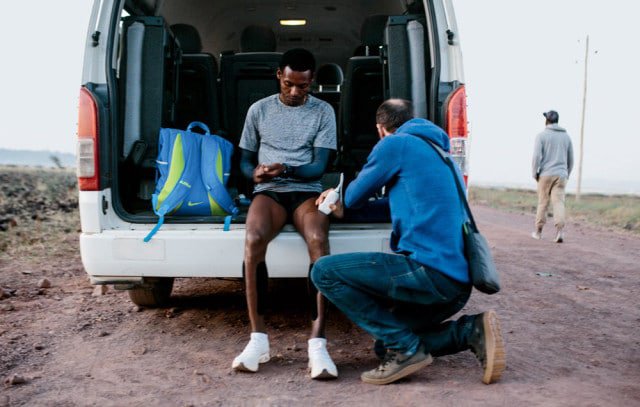
By the time the Breaking2 project was unveiled to the world, in mid-December, Kipchoge, Desisa, and Tadese were back training in their home countries. None of the science that the crew in Beaverton were sweating over would make any difference if the three protagonists didn’t arrive at the starting line in near-world-record shape. Each man kept training with his own coach, following the path that has brought him success. Nike’s team watched from afar, monitoring each workout through uploaded GPS and heart-rate data, running the workouts through a sophisticated computer program for analysis, and offering feedback and advice when requested.
In late January, a 12-person crew left Nike for a two-week, whirlwind trip to visit Kipchoge in Kenya, Desisa in Ethiopia, and Tadese in Spain, where he was training with his coach. The contrast between the high-tech pursuit of marginal gains and the simple life and elemental grind of elite African marathon training was striking. “It’s very humbling to see the Olympic champion hauling up cold water in a bucket from a well after his workout,” said Philip Skiba, D.O., Ph.D., a performance engineering consultant working with the Nike team. The trip’s mission was partly scientific, with more physiological testing for each athlete. It was partly product-focused, with shoe and apparel experts testing prototypes and seeking feedback in order to personalise the gear exactly to each athlete’s liking – tweaking the dimensions and fit on a scale of fractions of centimetres. But in some ways, the biggest goal was to build relationships and trust, in each other and in the project’s process and goals.
For example, Kirby brought a makeshift wearable wind-speed metre. It’s one thing to tell someone that a supercomputer has calculated that they must run exactly 81 centimetres behind their pacer, at an angle of 46 degrees to the left; it’s another to get on the track and run, moving back and forth in different drafting formations and then seeing exactly how the effective wind you face changes. Similarly, a portable ultrasound tool offered quick estimations of how much carbohydrate was stored in the runners’ leg muscles. Seeing the decline in fuel stores after a long run and determining how it could be delayed by drinking sports drink was a much more visceral demonstration of the importance of in-race fuelling than any lecture on sports nutrition.
By the end of the trip, the team was feeling cautiously optimistic. Kipchoge’s marathon best of 2:03:05, set in 2016, showed he was close to world-record fitness. “The other two,” Jones told me, “do look like they’re capable of 2:02, 2:03, 2:04, something like that, on the best possible day, which is kind of the area that we’d need to be in if you add all of these other factors like the drafting and the footwear and other bits and pieces that might get you closer to two hours.” Others weren’t so sure: The British oddsmakers Ladbrokes briefly offered punters the chance to double their money by betting against the project. As for the athletes themselves – in the end, the only votes that would matter – their confidence was growing. “Most of the people were saying they will die before they see a man running [a marathon] in under two hours,” Kipchoge told me. “But I think I will prove them wrong in May.”
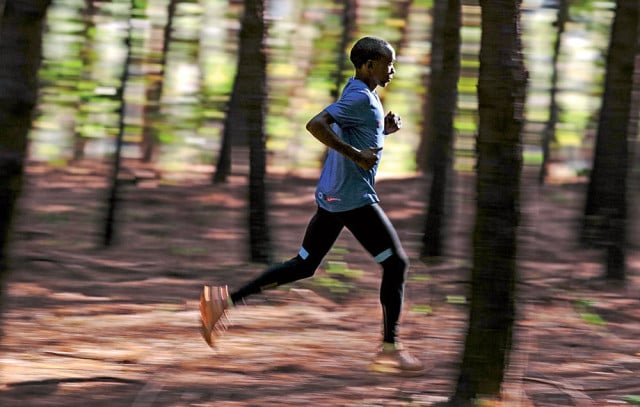
As the test half marathon wears on, Desisa drifts farther and farther back, his shorts billowing in the wind. This, too, is not part of the suggested apparel plan: The other two runners are wearing half tights with aerodynamic patterning and targeted bands of compression for muscle support. The half tights – along with a tighter-than-usual sleeveless tank top, textured aerodynamic tape on the inner and outer calves to reduce drag, and socks specially designed to grip the sole of both the foot and the shoe without slipping – are part of a grand rethink of apparel for marathoners. Due to improved aerodynamics, the overall package is expected to save “between one and 60 seconds,” says Nike Sport Research Lab physiologist Dan Judelson, Ph.D. “But even if it’s just one second, that would be significant. We would feel really bad if we didn’t try everything and they ran 2:00:01.”
Desisa, though, had made a game-day decision to switch back to the loose split shorts that elite marathoners usually wear to race, a sign, perhaps, that he is feeling out of his comfort zone. (Why, Judelson and his team had asked the Nike-sponsored runners whom they spoke to in Africa, do marathoners always compete in wind-grabbing split shorts? “Because that is what you give us.”)
Along the back straight, Kirby is clinging to the back of a moped and handing colour-coded bottles of water or sports drink to the runners as they pass, matching their speed so they don’t have to slow down to grab them. Drinking every 2.4K – or roughly every seven minutes – is about twice as often as the athletes are accustomed to doing in a race. The frequent drinking, using a mix of several different carbohydrate blends to speed absorption and reduce stomach discomfort, was designed to keep the athletes from bonking. Here, too, Desisa is somewhat out of his comfort zone. Before joining the project, he had been used to drinking little or nothing while running, so the fuelling plan is a key part of the rehearsal – but thanks to a logistical breakdown, he stops receiving bottles after dropping off the back of the pack.
RELATED: Test Run Yields Fast Times, Lingering Questions
As the race wears on, the pack of pacers at the front look increasingly ragged, but fresh runners continue to hop in eagerly whenever someone drops out. Kipchoge hovers close behind them, tracking every surge as the pace fluctuates with the wind. Then, with more than two laps remaining, Tadese, too, begins to drift backward from the main pack. The mood at the finish line cools even further as the late-afternoon sun begins to sink behind the cavernously empty grandstand on the far side of the track.
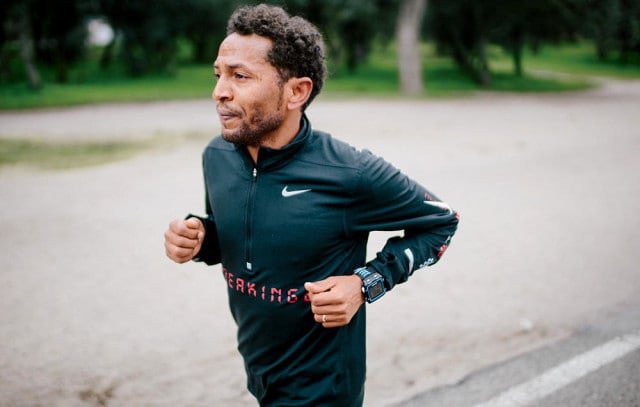
The world learned the details of Nike’s new shoe earlier that day. In addition to the custom models worn by the three stars, the company will offer mass market models priced at around R3380 and R2025; they dubbed the higher-end version the Zoom Vaporfly 4%, referring to the lab-tested boost in efficiency it offered compared to Nike’s previous fastest marathon shoe. The online reactions that poured in as Kipchoge, Tadese, and Desisa circled the track in Monza were not uniformly positive. The New York Times published a grainy CT scan of the Nike shoe, sent in by Yannis Pitsiladis of the rival Sub2Hr project, in which the carbon-fibre plate looked like a hidden knife revealed by airport security. The plate, the Times claimed, was “meant to act as a kind of slingshot, or catapult, to propel runners forward.” Were such spring-loaded shoes really fair?
The international rules on shoes, it turns out, are not illuminating. They forbid “any technology which will give the wearer any unfair advantage,” but what this means is not specified. The last two men’s marathon world records were set in Adidas shoes boasting its springy Boost foam, which in lab tests has been shown to offer, on average, a 1-percent gain in efficiency. Nike’s new foam appears to be a further improvement, but not a radical change.
The presence of a carbon-fibre plate is trickier to decode. Here, too, Adidas (along with other companies such as Fila) had already paved the way. In the early 2000s, some Adidas shoes incorporated a carbon-fibre “Pro Plate,” with a similar though less pronounced curve. Tests by Darren Stefanyshyn, Ph.D., a biomechanics researcher at the University of Calgary in Canada who helped develop the Pro Plate, showed that it, too, boosted efficiency by about 1 percent. The Pro Plate was eventually discontinued; Stefanyshyn’s understanding is that the cost of carbon fibre, which at the time was relatively rare and expensive, possibly sealed its fate. (It’s worth noting that Stefanyshyn was the Ph.D. advisor for Geng Luo, who was a key player on the Vaporfly design team for Nike; another of his former students helped with the design.) The Pro Plate data was all publicly available, so it’s not a question of transferring secret knowledge; still, the genealogy of the new shoe is not hard to trace, which undermines claims that it breaks any existing rules.
The idea that the shoes are “spring-loaded” does have a kernel of truth in it. “Virtually all modern running shoes already have springs,” says Rodger Kram, Ph.D., director of the University of Colorado’s Locomotion Laboratory, who conducted external testing on the shoes for Nike. “We call them foam midsoles.” The carbon-fibre plates, however, don’t add any additional springiness, according to Stefanyshyn. Instead, he says, the plate functions as a lever manipulating how the force is applied to the ground, while the curve of the plate allows the calf muscles to work at a more efficient length. It may also save some energy that is usually lost when the big toe bends.
However they work, the upshot is that – according to Kram’s testing, at least – they work. Is a shoe that offers on average a 4-percent gain in efficiency fair, especially when it’s not available, or even known, to competitors? For athletes like Kara Goucher, the news was cause for reflection. Goucher narrowly missed her third Olympic berth when she finished fourth at the U.S Olympic Marathon Trials in Los Angeles behind two athletes (Shalane Flanagan and Amy Cragg) wearing the then-secret shoe. “I was pretty upset when I heard about it,” she admitted in an RW interview. She counts Flanagan as a good friend, and her brother-in-law, as Nike’s senior director of global running, has been closely involved in the shoe’s development. She’s hesitant, therefore, to leap to conclusions. “But if technology is affecting races and what times people are running, if that is found to be an unfair advantage, then that’s an issue.”
Beyond the shoe, the whole premise of an exhibition event designed solely to break the two-hour barrier has rubbed some runners the wrong way – especially an event backed by a PR-savvy megacorporation that may not adhere to the sport’s usual rules. Running journalist Adharanand Finn told a British newspaper that the project is taking “a competitive, exciting sport, and turning it into a scientific experiment. I don’t like that.” Jos Hermens, the veteran athlete manager, has little time for such grousing. During his own running career in the 1970s, Hermens himself ventured outside the canonical running distances to set a pair of world records for the one-hour run; three decades later, he encouraged his athlete Haile Gebrselassie to do the same, in a solo time trial assisted by pacemakers. Such events, like the two-hour chase, connect with a broader public that isn’t usually poring over the latest marathon results, Hermens says. “It’s very good for our sport. People that never talk about it are talking about it.”
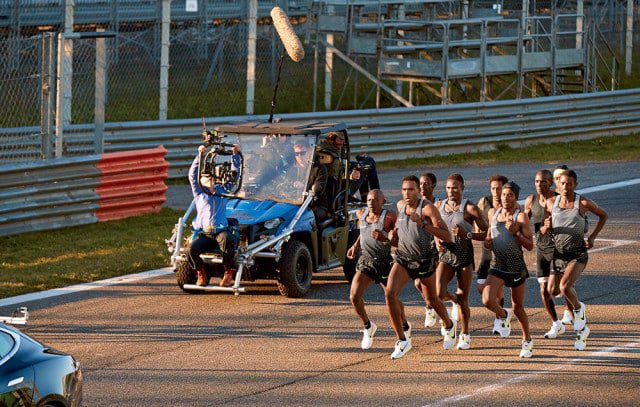
The light is fading as Kipchoge powers around the track for his final lap. To scattered applause, he crosses the finish line in a hard-to-fathom time of 59:19, and saunters over to a nearby scale where Jones is waiting to weigh him in order to calculate his sweat loss. Tadese, seemingly far adrift, still finishes in 59:42 – faster than Ryan Hall’s American half marathon record of 59:43. He could have gone faster, he later explains, but chose to stick instead to the pre-race plan of aiming for 60 minutes. Desisa, downcast but determined to finish, notches a 1:02:56.
Click here to listen to the RW Podcast about Breaking2.
After cooling down and getting their sweats on, the runners good-naturedly field questions from the scrum of journalists. In addition to the usual sports reporters, there are representatives from outlets focusing on design, health, and other topics, reflecting the widespread interest generated by the event. Desisa mentions a nagging injury that had slowed his training earlier in the year; it’s not clear, through his interpreter, how serious the injury was or whether it’s still bothering him. (He had hurt his knee last fall, Kirby explains later, and missed some training.) Kipchoge volleys a series of oddball questions (Did you have any meals? “Well, I had lunch.” But during the race, did you have any meals? “No, no meals during the race.” Is that a problem? Would you normally have a meal during a marathon? “No, you don’t need any meals during a marathon.”) before I ask the big one: How hard did he have to push to run 59:19? Was it 95 percent effort? 98 percent? 100 percent? He grins. “Sixty percent,” he says. “It was part of my training.”
RELATED: Why the Sub-2 Guys Will Bonk
The next day dawns crisp, sunny, and without a breath of wind – as if to prove Wilkins’s point about the benefits of a three-day launch window. It’s debriefing time for the science and operations teams. The shoe guys take close-up photographs of the race-worn prototypes, looking for telltale wrinkles in the foam or wear patterns on the sole that suggest needed tweaks. Desisa, chastened, confirms that he’s now committed to half tights. And the physiologists begin to sift through data collected by core-temperature pills that the runners swallowed before the race, as well as from taped-on muscle oxygen and skin-temperature sensors, to get a sense of whether they could have maintained the pace for twice as long. “One thing that was awesome about today,” says Wilkins, who’s itching to start the analysis, “is that nobody has data on a 59:19 half marathon. We have that now. So you put those into the models – we could break the models!”
But will they break the record, and, more important, the two-hour barrier? “My first sense was, yeah, we’ve got a lot of work to do,” Wilkins admits. The wind was disruptive, the drafting plan fell apart almost immediately, the execution of the fueling plan wasn’t perfect, Desisa was slow – all these things are worrying. But then the fact that two of the runners still managed to hit the goal pace is even more encouraging. Wilkins is confident that a sub-two marathon is humanly possible, but he knows all the details will have to fall into place perfectly on the day.
As he says this, I realise that in one important respect, he and his team have won me over. On my first visit to Beaverton last November, I was one of the skeptics who thought that two hours wouldn’t happen without a downhill course and wheeled shoes. I still think it’s a brazen long shot. But after watching Kipchoge and Tadese in action, I don’t think it’s an impossibility. I’ll come back to Monza in May, I decide. Because whether they land on the moon or flame out spectacularly en route, it’s going to be a hell of a show.
READ MORE ON: breaking2 Eliud Kipchoge nike

